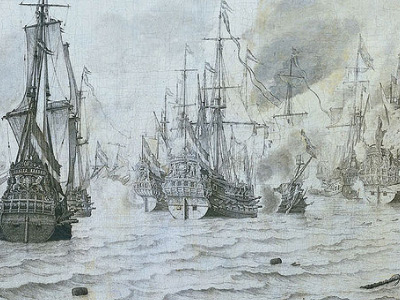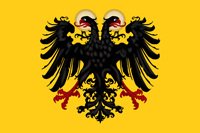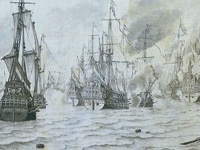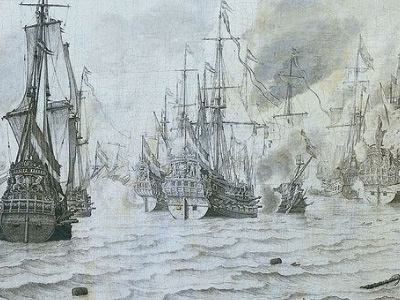Eighty Years' War (1568–1648)

Peace of Münster
The negotiations between Spain and the Republic formally started in January 1646 as part of the more general peace negotiations between the warring parties in the Thirty Years' War. The States General sent eight delegates from several of the provinces as none trusted the others to represent them adequately. They were Willem van Ripperda (Overijssel), Frans van Donia (Friesland), Adriaen Clant tot Stedum (Groningen), Adriaen Pauw and Jan van Mathenesse (Holland), Barthold van Gent (Gelderland), Johan de Knuyt (Zeeland), and Godert van Reede (Utrecht). The Spanish The Spanish Empire was a colonial empire governed by Spain and its predecessor states between 1492 and 1976. One of the largest empires in history, it was the first to usher the European Age of Discovery and achieve a global scale, controlling vast territory. It was one of the most powerful empires of the early modern period, reaching its maximum extent in the 18th century. delegation was led by Gaspar de Bracamonte, 3rd Count of Peñaranda. The negotiations were held in what is now the Haus der Niederlande in Münster.
The Spanish Empire was a colonial empire governed by Spain and its predecessor states between 1492 and 1976. One of the largest empires in history, it was the first to usher the European Age of Discovery and achieve a global scale, controlling vast territory. It was one of the most powerful empires of the early modern period, reaching its maximum extent in the 18th century. delegation was led by Gaspar de Bracamonte, 3rd Count of Peñaranda. The negotiations were held in what is now the Haus der Niederlande in Münster.
The Dutch The Dutch Republic was a confederation that existed from 1579, during the Dutch Revolt, to 1795. It was a predecessor state of the Netherlands and the first fully independent Dutch nation state. Although the state was small and contained only around 1.5 million inhabitants, it controlled a worldwide network of seafaring trade routes. The income from this trade allowed the Dutch Republic to compete militarily against much larger countries. It amassed a huge fleet of 2,000 ships, initially larger than the fleets of England and France combined. and Spanish delegations soon reached an agreement, based on the text of the Twelve Years' Truce. It therefore confirmed Spain's recognition of Dutch independence. The Dutch demands (closure of the Scheldt, cession of the Meierij, formal cession of Dutch conquests in the Indies and Americas, and lifting of the Spanish embargoes) were generally met. However, the general negotiations between the main parties dragged on, because France
The Dutch Republic was a confederation that existed from 1579, during the Dutch Revolt, to 1795. It was a predecessor state of the Netherlands and the first fully independent Dutch nation state. Although the state was small and contained only around 1.5 million inhabitants, it controlled a worldwide network of seafaring trade routes. The income from this trade allowed the Dutch Republic to compete militarily against much larger countries. It amassed a huge fleet of 2,000 ships, initially larger than the fleets of England and France combined. and Spanish delegations soon reached an agreement, based on the text of the Twelve Years' Truce. It therefore confirmed Spain's recognition of Dutch independence. The Dutch demands (closure of the Scheldt, cession of the Meierij, formal cession of Dutch conquests in the Indies and Americas, and lifting of the Spanish embargoes) were generally met. However, the general negotiations between the main parties dragged on, because France The Kingdom of France is the historiographical name or umbrella term given to various political entities of France in the medieval and early modern period. It was one of the most powerful states in Europe since the High Middle Ages. It was also an early colonial power, with possessions around the world. Colonial conflicts with Great Britain led to the loss of much of its North American holdings by 1763. The Kingdom of France adopted a written constitution in 1791, but the Kingdom was abolished a year later and replaced with the First French Republic. kept formulating new demands. Eventually it was decided therefore to split off the peace between the Republic and Spain from the general peace negotiations. This enabled the two parties to conclude what technically was a separate peace (to the annoyance of France, which maintained that this contravened the alliance treaty of 1635 with the Republic).
The Kingdom of France is the historiographical name or umbrella term given to various political entities of France in the medieval and early modern period. It was one of the most powerful states in Europe since the High Middle Ages. It was also an early colonial power, with possessions around the world. Colonial conflicts with Great Britain led to the loss of much of its North American holdings by 1763. The Kingdom of France adopted a written constitution in 1791, but the Kingdom was abolished a year later and replaced with the First French Republic. kept formulating new demands. Eventually it was decided therefore to split off the peace between the Republic and Spain from the general peace negotiations. This enabled the two parties to conclude what technically was a separate peace (to the annoyance of France, which maintained that this contravened the alliance treaty of 1635 with the Republic).
The text of the Treaty (in 79 articles) was fixed on 30 January 1648. It was then sent to the principals (King Philip IV of Spain and the States General) for ratification. Five provinces voted to ratify (against the advice of stadtholder William) on 4 April (Zeeland and Utrecht being opposed). Utrecht finally yielded to pressure by the other provinces, but Zeeland held out and refused to sign. It was eventually decided to ratify the peace without Zeeland's consent. The delegates to the peace conference affirmed the peace on oath on 15 May 1648 (though the delegate of Zeeland refused to attend, and the delegate of Utrecht suffered a possibly diplomatic illness).
In the broader context of the treaties between France and the Holy Roman Empire The Holy Roman Empire was a political entity in Western, Central, and Southern Europe that developed during the Early Middle Ages and continued until its dissolution in 1806 during the Napoleonic Wars. From the accession of Otto I in 962 until the twelfth century, the Empire was the most powerful monarchy in Europe. The empire reached the apex of territorial expansion and power in the mid-thirteenth century, but overextending led to partial collapse., and Sweden and the Holy Roman Empire of 14 and 24 October 1648, which comprise the Peace of Westphalia, but which were not signed by the Republic, the Republic now also gained formal "independence" from the Holy Roman Empire, just like the Swiss Cantons. In both cases this was just a formalisation of a situation that had already existed for a long time. France and Spain did not conclude a treaty and so remained at war until the peace of the Pyrenees of 1659. The peace was celebrated in the Republic with sumptuous festivities. It was solemnly promulgated on the 80th anniversary of the execution of the Counts of Egmont and Horne on 5 June 1648.
The Holy Roman Empire was a political entity in Western, Central, and Southern Europe that developed during the Early Middle Ages and continued until its dissolution in 1806 during the Napoleonic Wars. From the accession of Otto I in 962 until the twelfth century, the Empire was the most powerful monarchy in Europe. The empire reached the apex of territorial expansion and power in the mid-thirteenth century, but overextending led to partial collapse., and Sweden and the Holy Roman Empire of 14 and 24 October 1648, which comprise the Peace of Westphalia, but which were not signed by the Republic, the Republic now also gained formal "independence" from the Holy Roman Empire, just like the Swiss Cantons. In both cases this was just a formalisation of a situation that had already existed for a long time. France and Spain did not conclude a treaty and so remained at war until the peace of the Pyrenees of 1659. The peace was celebrated in the Republic with sumptuous festivities. It was solemnly promulgated on the 80th anniversary of the execution of the Counts of Egmont and Horne on 5 June 1648.
HISTORY

RESOURCES
This article uses material from the Wikipedia article "Eighty Years' War (1568–1648)", which is released under the Creative Commons Attribution-Share-Alike License 3.0.
© Stories Preschool. All Rights Reserved.









